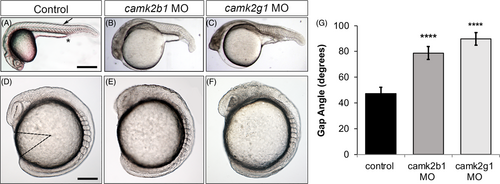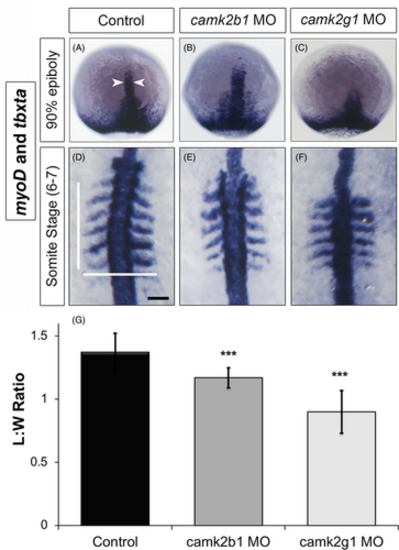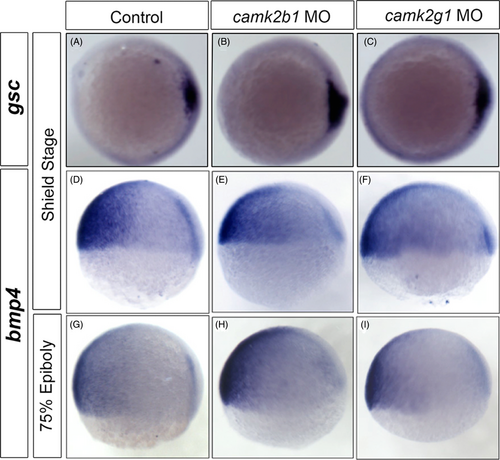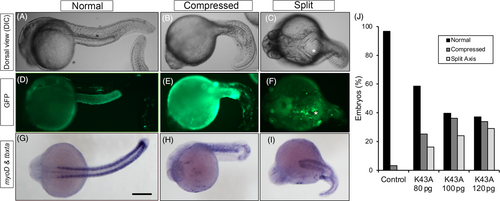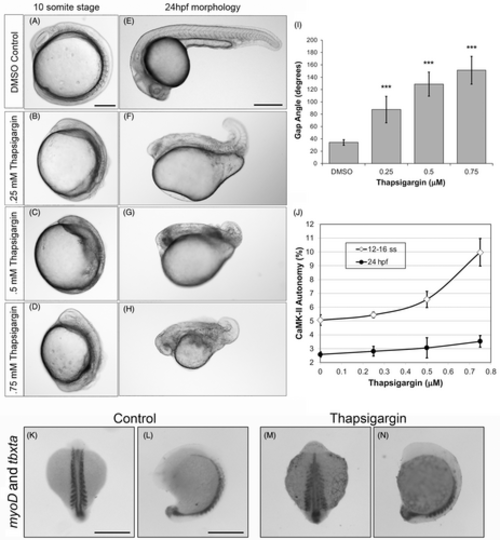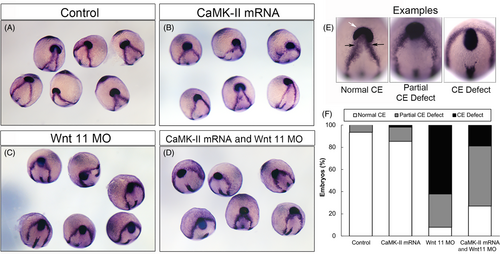- Title
-
Specific CaMKIIs mediate convergent extension cell movements in early zebrafish development
- Authors
- McLeod, J.J., Rothschild, S.C., Francescatto, L., Kim, H., Tombes, R.M.
- Source
- Full text @ Dev. Dyn.
|
camk2b1 and camk2g1 morphant phenotypes. (A–C). Lateral view of 24hpf zebrafish embryos injected with 3 ng mismatch morpholino oligonucleotide (MO), 3 ng camk2b1 MO, or 1.5 ng camk2g1 MO. Control embryos show evenly spaced somites (arrow) with full yolk extension (asterisk). Camk2b1 morphants exhibit compression of the somites, curvature of the tail and reduced yolk extension. Camk2g1 morphants lack yolk and tail extension and exhibit compression of the somites. Scale bar 0.5 mm. (D–F) Lateral view images at the 10 somite stage (ss) of representative morphant embryos. Body gap angles were derived from the head-yolk-tail angle (dashed lines, D). Scale bar 0.25 mm. (G) Body gap angles of embryos at the 10–11ss were averaged from 34 to 80 embryos per condition across three replicated matched studies. ****p < .0001 compared to control. |
|
camk2b1 and camk2g1 morphants display hypoblast movement defects. Dorsal views of representative morphant embryos injected with 3 ng mismatch morpholino oligonucleotide (MO), 3 ng camk2b1 MO, or 1.5 ng camk2g1 MO and then probed for myoD and tbxta at 90% epiboly (A–C) and at the 6–7 somite stage (ss) (D–F). (G) length:width (L:W) ratios at the 6–7ss were averaged from 24 to 29 embryos per condition across three replicated matched studies. Length was measured from the anterior region of somite 1 to the posterior region of somite 6 (denoted by vertical white line) and width of somite 6 (denoted by horizontal white line). Scale bar 0.05 mm. ***p < .001 |
|
camk2b1 and camk2g1 morphants display convergent extension defects at the tailbud stage. Representative morphant embryos injected with 3 ng mismatch morpholino oligonucleotide (MO), 3 ng camk2b1 MO, or 1.5 ng camk2g1 MO were probed at the 1–3 somite stage simultaneously for the expression of ctslb, dlx3, and tbxta. Dorsal views of representative embryos at their (A–C) anterior and (D–F) posterior ends. Arrows indicate dlx3 expression. White bar denotes band of tbxta expression across developing notochord. |
|
Cell fate specification is unaltered in CaMKII morphants. Representative morphant embryos injected with 3 ng mismatch morpholino oligonucleotide (MO), 3 ng camk2b1 MO or 1.5 ng camk2g1 MO are shown at shield (A–F) and 75% epiboly (G–I) stages with dorsal to the right. (A–C) Animal pole view probed for the dorsal side organizer gsc. (D–I) Lateral view probed for bmp4 expression. |
|
Proliferation and Apoptosis are unaltered in CaMKII morphants. Lateral views of representative morphant embryos injected with 3 ng mismatch morpholino oligonucleotide (MO), 3 ng camk2b1 MO. or 1.5 ng camk2g1 MO after immunostaining for phospho-histone H3 (green, left panel) or cleaved caspase-3 (green, right panel) and propidium iodide (red) at shield and 75% epiboly stages. Proliferation (center panel) was the percentage of cells in mitosis at both shield and epiboly averaged from three experiments, at least 3 embryos per condition and five regions of interest per embryo. There were no statistically significant differences between conditions. Cleaved caspase-3 positive cells are marked by an asterisk. |
|
Ectopic expression of dominant-negative CaMKII induces convergent extension (CE) defects. Embryos were injected with GFP-tagged dominant-negative (K43A) CaMKII cDNA and observed at 24hpf in differential interference contrast light (A–C) and fluorescent (D–F) optics. Embryos with normal, compressed, and split morphologies are shown and were also fixed and probed for tbxta and myoD expression (G–I). Individual fluorescent cells can be seen between the split axes and are marked by an asterisk (C, F). Bar chart represents the accumulated categorization of 58–93 embryos for each level of cDNA injected which spanned seven separate experiments. |
|
Persistent Ca2+ elevations during gastrulation activate CaMKII and cause cell migration defects. Zebrafish embryos were treated with thapsigargin (TG) between 5 and 7hpf, washed free of TG and then harvested or imaged later. (A–H) Images of 10ss and 24hpf embryos after transient treatment with the indicated concentration of TG-treated embryos. Scale bar 0.25 mm (A) and 0.5 mm (E). (I) Body gap angles of control dimethyl sulfoxide and TG-treated embryos were measured at the 10 ± 1 somite stage (ss) and averaged from 17 to 54 embryos, ***p < .001. (J) CaMKII-specific activity was measured in whole embryo lysates of 12–16ss and 24hpf embryos after transient TG treatment using the autocamtide-2 peptide–based assay. CaMKII autonomy represents the percentage of whole embryonic CaMKII that is activated and thus Ca2+/CaM-independent. (K–N) Dorsal and lateral views of representative 15ss embryos either untreated or transiently treated with TG as described above and then probed for myoD and tbxta. Anterior is at top. Scale bar 0.5 mm. |
|
Overexpression of CaMKII partially rescues the convergent extension (CE) defect of Wnt11 morphants. (A–D) Morphant embryos injected with 3 ng wnt11 morpholino oligonucleotide with or without CaMKII mRNA are shown at the 1–3 somite stage after in situ hybridization with a combination of the ctslb, dlx3, and tbxta probes as in Figure 3. (E) Individual examples of normal, partial, and defective CE with ctslb denoted by a white arrow and dlx3 by black arrows. (F) The percentage of embryos for each condition were scored for normal CE, partial CE defect or CE defect. Three separate experiments yielded 55–107 embryos for each condition. |

